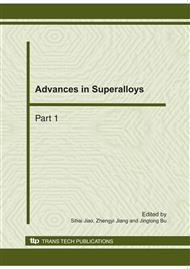[1]
GB50021-2001, Code for investigation of geotechnical engineering[S]. Beijing: China Architecture & Building Press, 2002 (In Chinese).
Google Scholar
[2]
Chai Shou-xi, Yang Bao-zhu, Wang Xiao-yan, et al. Analysis of salinization of saline soil in west coast area of Bohai gulf[J]. Rock and Soil Mechanics, 2008, 29(5): 1 217-1 222 (In Chinese).
Google Scholar
[3]
Zhou Qi, Han Wen-feng, Deng An, et al. Influences on unconfined compressive strength of stabilized coastal saline soils[J]. Chinese Journal of Geotechnical Engineering, 2006, 28(9): 1 177-1 180 (In Chinese).
Google Scholar
[4]
Wang Jin-fen, Liu Xue-mei, Wang Xi-ying. Effect of the saline soil restoration material on soil amendment[J]. Journal of Anhui Agri, 2006, 34(17): 4 353-4 354 (In Chinese).
Google Scholar
[5]
Wei Li, Chai Shou-xi, Cai Hong-zhou. Evaluation of anticorrosive measures for wheat straw and strengthening mechanism of reinforced saline soil in littoral area[J]. Geotechnical Investigation & Surveying, 2009, (1): 5-7 (In Chinese).
Google Scholar
[6]
Mosleh A. Al-Shamrani. Applicability of the rectangular hyperbolic method to settlement predictions of sabkha soils[J]. Geotechnical and Geological Engineering, 2004, 22: 563-587.
DOI: 10.1023/b:gege.0000047046.73649.04
Google Scholar
[7]
Abdullah A. Sabtan. Performance of a steel structure on Ar-Rayyas Sabkha soils[J]. Geotechnical and Geological Engineering, 2005, 23: 157-174.
DOI: 10.1007/s10706-003-5200-y
Google Scholar
[8]
Shangguan Yun-long, Shi Feng, Luan Mao-tian, et al. Test studies and FEM analysis on structural performance of embankment slops reinforced by geogrids[J]. Journal of Jilin University (Earth Science Edition), 2006, 36(Supp): 80-84 (In Chinese).
Google Scholar
[9]
Wu Jinghai, Wang Dequn, Wang Lingjuan, et al. Experimental study on geosynthetic reinforcement[J]. China Civil Engineering Journal, 2002, 35(6): 93-99 (In Chinese).
Google Scholar
[10]
Li Guangxin, Chen Lun, Zheng Jiqin, et al. Experimental study on fiber-reinforced cohesive soil[J]. Journal of Hydraulic Engineering, 1995, 26(6): 31-36 (In Chinese).
Google Scholar
[11]
Ghiassian H., Poorebrahim G. R., and Grey D. H. Soil reinforcement with recycled carpet wastes[J]. Journal of Waste Management & Research, 2004, 22(2), 108-114.
DOI: 10.1177/0734242x04043938
Google Scholar
[12]
T. F Zimmie, A. Pzmuk, K. Adalier, et al. Retrofit-reinforcement of cohesive soil slopes using high strength geotextiles with drainage capability[J]. Geotechnical and Geological Engineering, 2005, 23: 447-459.
DOI: 10.1007/s10706-004-9113-1
Google Scholar
[13]
Youventharan Duraisamy, Bujang B. K. Huat, Ratnasamy Muniandy. Compressibility behavior of fibrous peat reinforced with cement columns[J]. Geotech Geol Eng, 2009, 27: 619-629.
DOI: 10.1007/s10706-009-9262-3
Google Scholar
[14]
Lian Hai-lan, Pan Ming-zhu, Zhou Li-li, et al. Study on water absorption of rice straw MDF[J]. China Forest Products Industry, 2009, 36(5): 30-34 (In Chinese).
Google Scholar
[15]
Ikuo Momohara, Yuko Ota, Takeshi Nishimura. Assessment of decay risk of airborne wood-decay fungi[J]. The Japan Wood Reasearch Society, 2010, online first.
DOI: 10.1007/s10086-009-1093-6
Google Scholar
[16]
Yudith Guilen, David Navias, Angela Machuca. Tolerance to wood preservatives by copper-tolerant wood-rot fungi native to south-central Chile[J]. Biodegradation, 2009, 20: 135-142.
DOI: 10.1007/s10532-008-9207-1
Google Scholar
[17]
Anna Hyvonen, Mikko Nelo, Petteri Piltonen, et al. Using the emulsion technique and an iron catalyst to enhance the wood protection properties of tall oil[J]. Hola Roh Werkst, 2007, 65: 247-249.
DOI: 10.1007/s00107-006-0156-2
Google Scholar
[18]
Liu Xiao-ming, Zhao Ming-hua, Su Yong-hua. Study on slaking control method of red beds soft rock used in road construction[J]. Rock and Soil Mechanics, 2005, 26(Supp. ), 111-114 (In Chinese).
Google Scholar
[19]
Wang Yang, Yin Kun-long, An Guang-feng. Grey correlation analysis of sensitive factors of landslide[J]. Rock and Soil Mechanics, 2004, 25(1), 91-93 (In Chinese).
Google Scholar
[20]
Shan Ren-liang, Huang Bao-long, Li Guang-jing. Comprehensive evaluation model based on grey correlative analysis and its application to selecting blasting scheme[J]. Rock and Soil Mechanics, 2009, 30(Supp. ), 206-210 (In Chinese).
Google Scholar
[21]
Deng Ju-long. The primary methods of grey system theory[M]. Wuhan: Huazhong University of Science & Technology Press, 1987 (In Chinese).
Google Scholar
[22]
Wang Yin-mei, Chen Wen-wu, Han Wen-feng. Micro-study on mechanism of sand fixation with SH[J]. Rock and Soil Mechanics, 2005, 26(4): 650-654 (In Chinese).
Google Scholar
[23]
LY/T1283-1998. Method of laboratory test for toxicity of wood preservatives to decay fungi[S]. Beijing: Standards Press of China, 2004 (In Chinese).
Google Scholar
[24]
D1413b-2005. Standard Test Method for Wood Preservatives by Laboratory Soil-Block Culture[S]. ASTM Committee, (2005).
Google Scholar
[25]
Yang Guang-qing, Pang Wei, Lu Peng, et al. Experimental study of tensile properties of geogrids[J]. Rock and Soil Mechanics, 2008, 29(9): 2 387-2 391 (In Chinese).
Google Scholar
[26]
Jiao Ya-nan, Li Jia-lu, Han Xue-mei, et al. Experimental investigation on tensile property of stitching joint 3D braided composites[J]. Acta Material Composite Sinica, 2008, 25(1): 127-133 (In Chinese).
Google Scholar
[27]
Ma Xiao-jun, Zhao Guang-jie. Mechanical properties of carbon fiber precursors prepared from liquefied wood in phenol[J]. Journal of Beijing Forestry University, 2008, 30(2): 133-137 (In Chinese).
Google Scholar


